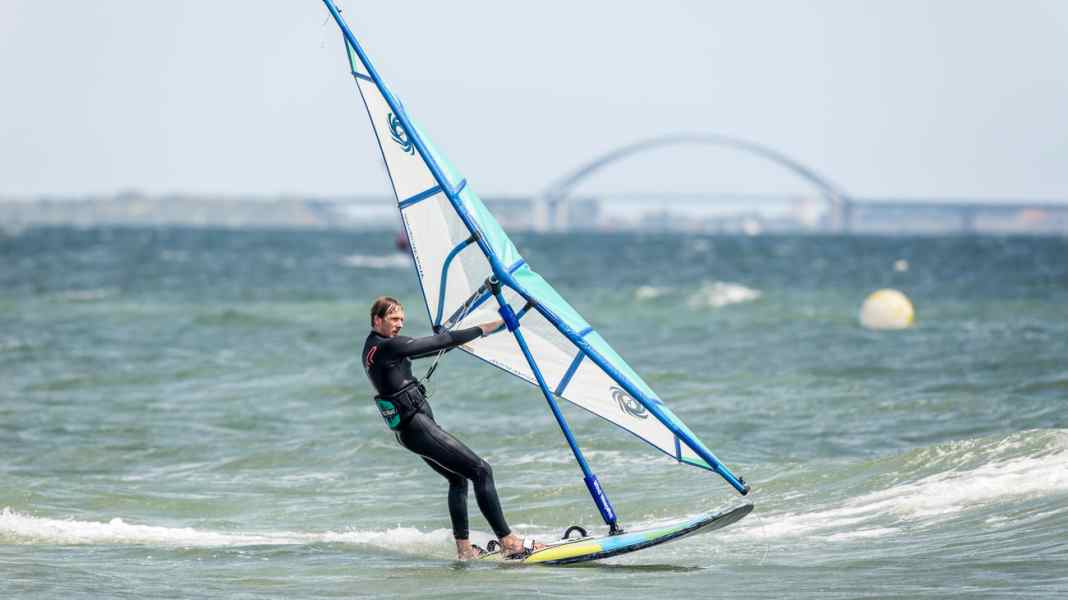
Spring 2017 - History Special in surf magazine. One office over, my editor-in-chief Andreas Erbe can barely look out over the piles of old surf magazines. Since he's been trawling through the archive for the craziest inventions in the 50-year history of windsurfing, the mountain of magazines, slides and yellow Post-it notes on his desk has been growing towards the ceiling every day. He pays me a visit at regular intervals to present his "latest" finds: "Look, the Tinkler tail, I had that too! Here, a football fin, amazing! And this is a channel fitting from the Charchulla twins, they were the first to surf across the English Channel with this thing in May 1975." As an editor in my mid-30s, I nod my head and don't understand a thing. The first thing I remember is a surf cover from the late 80s. A surfer is floating through the air under a kind of kite, seemingly weightless. No history special should be without something like that! And what happened to it anyway?
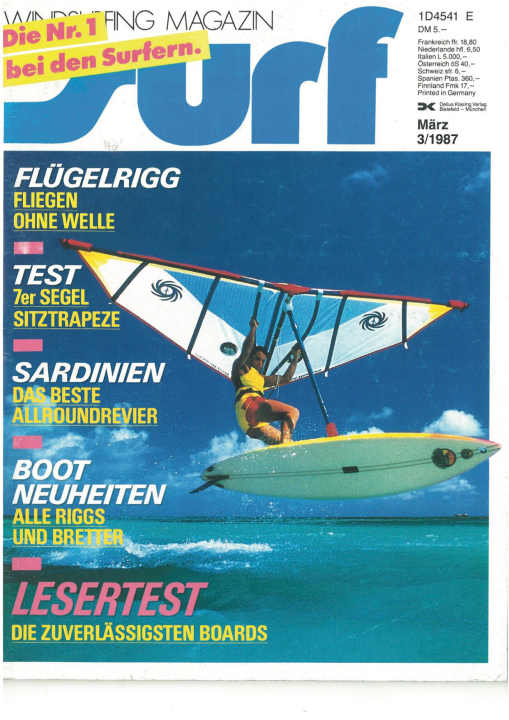
The search leads us to Uli Stanciu, editor-in-chief at surf from 1977 to 1989: "Yes, that was Tom Magruder's Wind Weapon, a mixture of surf sail and kite. Years earlier, I had already developed a kite sail called "The Wing" with Jim Drake, which was held free over the head. Magruder then connected the kite to the board via a fixed mast, which made things much easier. I think I still have one of these in my attic. Would you like to try it out?" It doesn't take long before it's actually there - the legendary Wind Weapon. The luggage label from the airport is still hanging on the handle, handwritten: Flight United Airlines UA 33-55-59.
Mission 1: Puzzles
Now I'm standing on the beach in Heiligenhafen with my mate Marius Gugg, World Cup pro Vincent Langer and photographer Oli Maier. I open my bag and take everything out. A short time later, we are surrounded by various aluminium tubes of different lengths, wingsails in several sizes, plastic trim hooks, a boom with three spars and almost 20 pre-curved aluminium batten. While I try to get an initial overview, the others inspect the 30-year-old base plate. Not even Marius would go out with something like this - and he really knows his way around surfing antiques, as he could easily open a surf museum with the contents of his surf cellar.
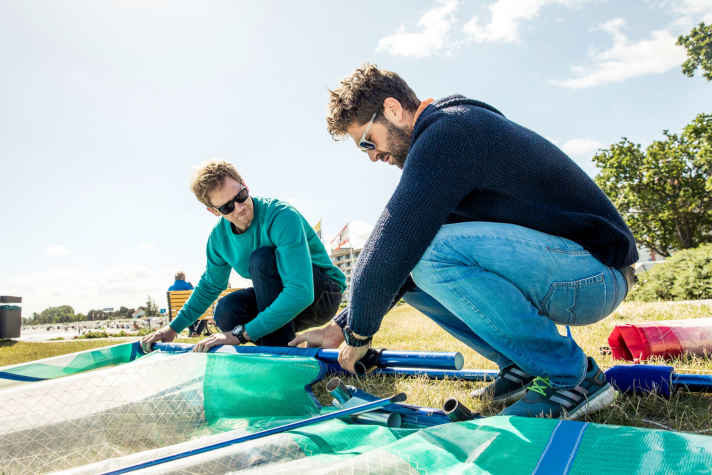
Even my pointing out that the base plate is "new and unused" doesn't quite convince them. After ten minutes of rigging, we were just as far along as before. Plug & Play was apparently still a foreign concept back then. The fact that you can cut off your fingertips when operating the aluminium push buttons was apparently also shrugged off in the past. "My racing sails don't have a profile like that," says Vinc, looking at the batten. I decide to postpone negotiations about the purchase price until later.
Plug & Play was obviously still a foreign concept in the 80s
We're beginning to understand the principle behind the setup, and while we put the last pieces of the puzzle together, Marius gets the boards. 2018 models, brand new. No-one is interested in them, instead an illustrious group of hobby surfers are gathered around the Wind Weapon, all ready to offer help and advice. Everyone who sets up here comes running up with wide eyes. Everyone over 50: "Boooah, a Wind Weapon!" Awesome!". The youngsters, however, assume that this is a prototype and want to know when this new product will be launched on the market. It's a generational thing.
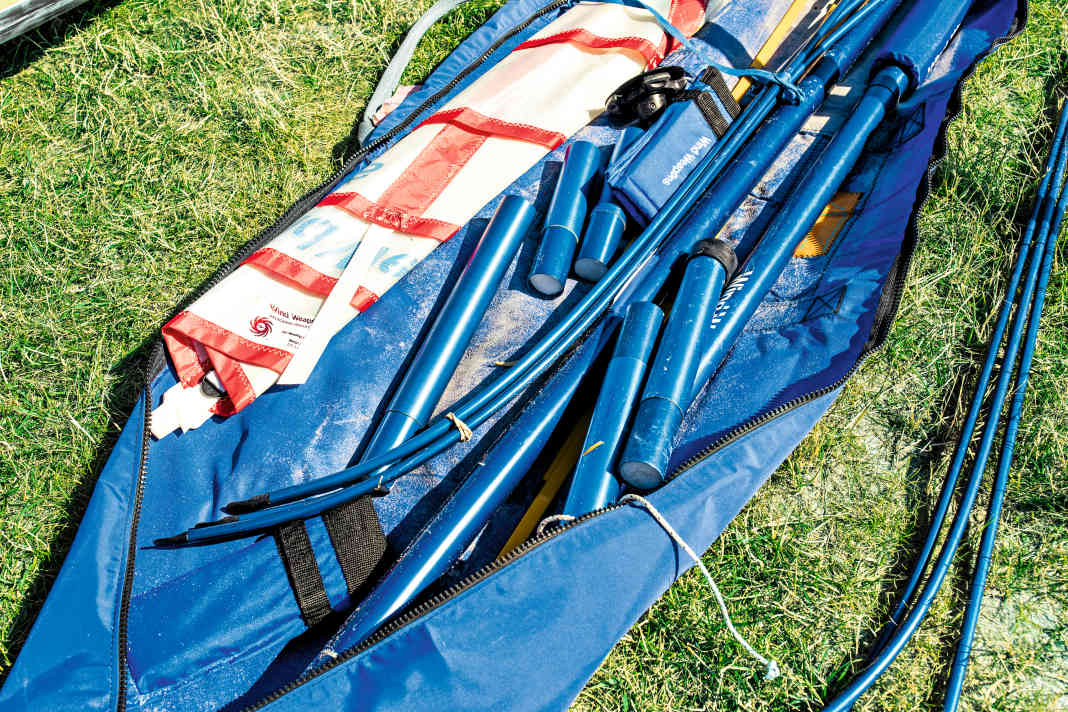





Mission 2: Get out of the windsurfing mindset
Before we go out on the water, we do our research. After all, we're not amateurs and want to be fully prepared for the water. An old YouTube video called "Tom Magruder and the Wind Weapon" shows the inventor at work. With no particular background in aerodynamics, Magruder tried out a symmetrical wing rig in the 1980s, relying solely on his experience as a windsurfer and kite flyer. In the video, he sails across the Columbia River in Oregon in 40 knots of wind, winds up, folds the wing rig horizontally and flies through the air ten metres high like a hang-glider, before landing as smooth as butter, repositioning the rig vertically and gliding on: "It started as a dream to fly like a sea bird," Tom announces right at the beginning with the usual American pathos. To jibe, Magruder simply folds the Wind Weapon horizontally over his head - he doesn't have to get out of the harness. Everything clear?
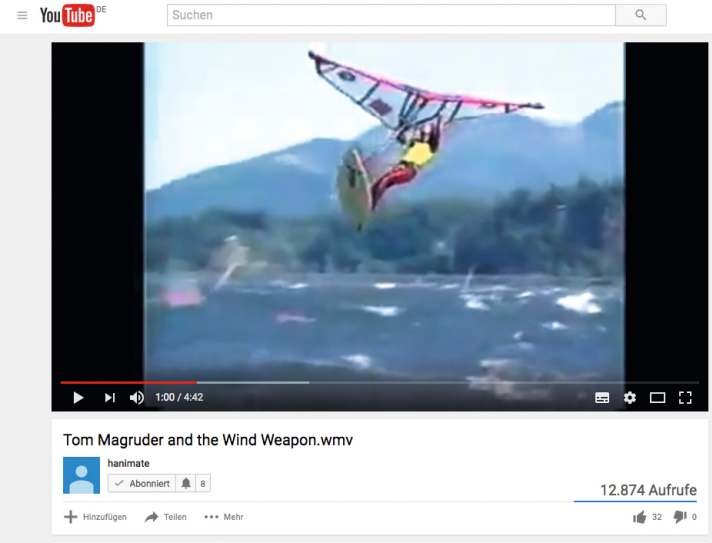
While Oli stows his camera in the water housing, we try to unravel the knots in our brains left by the video: Three boom spars on one side, set the sail horizontally to fly, and don't shi-fi during manoeuvres, just fold the thing up! Well then... Two of us tow the monster to the water. The westerly wind is whistling, the sun is shining. Marius makes the start. Beach start? Easy! A short time later, we glide out on the beam sheet, he with the gun, me with my 5.4 wave sail. We miss our agreed photo spot by a mere 100 metres. Because things are going so well, Marius gives us a lot of chain and doesn't think about turning round. Then the first jibe. Knots in the brain, knots in the arms. Marius jibes, of course. The unprotected aluminium mast crashes into the brand-new board at full speed. Laughter. Meanwhile, the rig is wedged under the water like a drift anchor. Marius pulls, pushes, turns - nothing happens. I let my equipment float and come to his aid. The two of us continue to pull, push and turn. Finally she comes free, but everything is pointing towards the open sea and we want to head back towards the shore, where Oli is waiting with the camera. To start towards land, Marius does what you do as a windsurfer in such a case: turn the board round and SHIFT the rig. NO!!! With a loud crunch, an aluminium push button immortalises itself in the deck. Knots in the brain, lactic acid in the arms. Nobody has to laugh now. After another ten minutes, the board finally points towards the beach and the wing rig floats "ready to waterstart" freely in the air. However, only Marius' arms and feet are sticking out of the water, the rest is gurgling somewhere beyond sea level. The thing is obviously completely horizontal during the water start and Marius makes no effort to lift it up. As he is about to collapse, I try to do so, also without success.
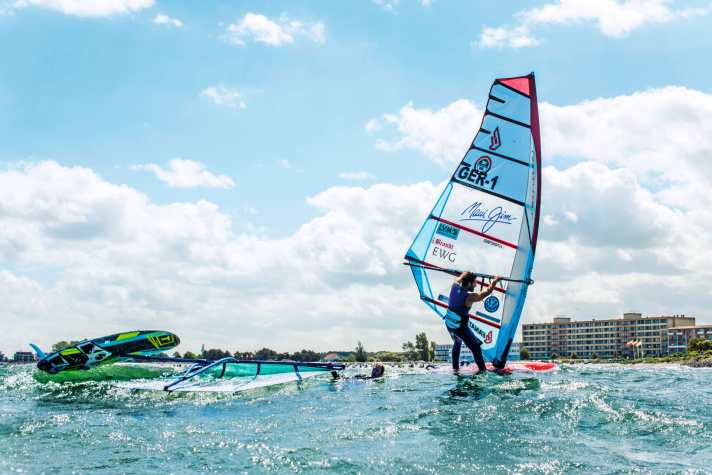
Mission 3: Water launch
A few days earlier, I had tried to find Tom Magruder on the Internet to get some tips from him. What do I need to bear in mind? What is the best way to start? How do you turn round? Is it dangerous? As I couldn't find him via the usual social media channels and Google, I started writing emails to locals, surf communities and surf shops in the Columbia River Gorge, asking them to pass me on. Although Tom Magruder still seemed to live there and be known like the back of his hand, and I was promised that my questions would be forwarded to him, I waited in vain for a reply.
The unprotected aluminium mast crashes onto the brand-new board at full speed. Laughter.
In view of our current situation, however, it also seems quite possible that he drowned under his own invention at some point while trying to take off and floated down the Columbia River. The videos only ever show it surfing and flying, never taking off. Somehow it must be possible to water-launch it! In the distance, Oli's helmet shines as a small green dot in the water: "I've got a 50mm lens on it, just jump eight to ten metres past me," was his briefing before the launch. Meanwhile, on the leeward side, the Fehmarnsund bridge is slowly getting bigger; a tourist on the beach has probably already alerted the sea rescue service. After another ten minutes, we give up and start swimming - me after my drifting windsurfing equipment, Marius with the Wind Weapon towards the beach. At some point, Vincent finally comes down with his slalom equipment and tows us off: "When I see you like this, I realise why this thing hasn't caught on," laughs Vinc. Further humiliation follows on the beach when attentive beachgoers point out our failure. Meanwhile, Oli eagerly continues to splash around at the agreed meeting point, probably taking photos of seagulls, tufts of seaweed and amateur surfers. One thing is certain: If we want to produce a usable photo at all today, we need a new strategy.
Mission 4: Learn to fly
When we arrive back at Oli's 30 minutes later after our "walk of shame", he gives us some "valuable" tips: "Just don't drive so far out and closer to me." Marius has either swallowed a cable or his carotid artery is swelling. Vincent has witnessed the drama and, contrary to his nature, takes a back seat: "You go first, Manu!".
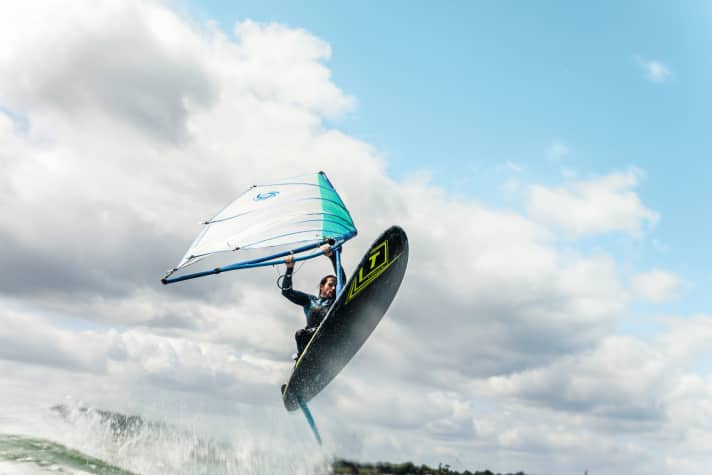
I heat up, aim for the small ramp and take off next to Oli. Magruder 2.0! Oli had better switch to portrait format, otherwise I'll fly out of the picture. "Wow, the fin was almost out," grins Oli as Vincent tows me back to the shore a short time later. If I wasn't clinging to the foot strap of my world champion shuttle, I'd be slapping the guy right now.
After witnessing our "impressive" performance, the master also wants to get in on the action - as he lines up for the beach start, the aluminium mast scrapes across Vincent's new slalom board. He takes it close and glides past the photo lens with his favourite son-in-law grin at the perfect distance. Outside, it's into the jibe. He also has knots in his brain, but with his tree-trunk arms he is still waving and manoeuvring the wing around long after he has stopped gliding. But in the end, even he is caught by the target. "So Vinc, do you need a lift to the beach?" I ask, not without a little malicious glee, before adding: "If you manage a water start, I'll buy you a crate of beer!"
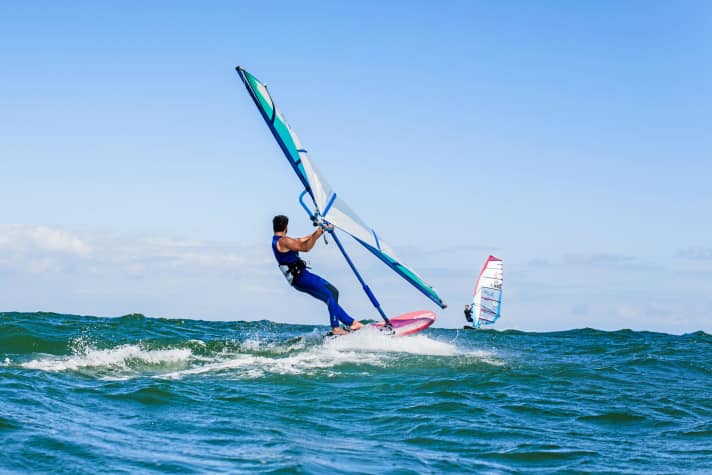
Less than ten seconds later, Vincent is standing on deck, Wind Weapon in hand, celebrating. But he still doesn't get any beer! The sack has screwed up and simply heaved the thing out of the water. Tree trunk arms!
Mission 5: Think ahead
It's starting to work: we use the small Baltic Sea kickers to create something like the feeling of flying for the first time. The profile does indeed act like an aerofoil and even if we don't soar into orbit like the guys from the Columbia River, you can still feel the delayed descent that once made the Wind Weapon so special. Manoeuvres, on the other hand, remain a mystery. During my power jibes, I regularly fail to fold the rig horizontally over my head in time and instead stick the bottom corner into the water at full speed. Fortunately, I slow down the stretched flying jib over the bow with my shin on the mast or I get my paws caught somewhere between the aluminium poles. However, the change to the tack brings decisive progress: although I crash here too, I am at least in a suitable water start position to start back towards the shore. As I hang under the kite again and gurgle, I intuitively grab the mast with my front hand, slide far down and lo and behold: the Wind Weapon straightens up and I get the necessary lift for the water start. After a few more strokes, my arms are sore from the thick boom, my legs tired from pedalling and of course the long "walk of shame".
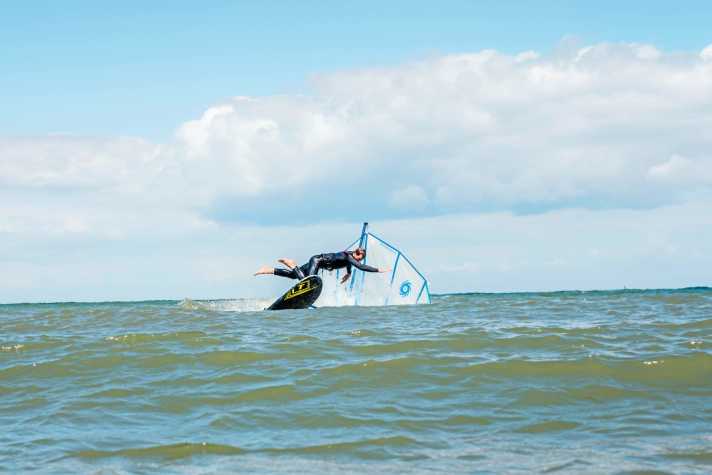
Back on the beach, we are bombarded with questions: How was it? Was it fun? Why didn't you fly? Meanwhile, Vincent is thinking aloud to himself that something like this should be reissued - lighter, more modern and of course without all the suicidal features. "Actually," he says, "this thing should be ideal for foiling. It delivers a lot of propulsion and pulls upwards rather than forwards, which is exactly what you need. I'll suggest it to the North guys."
Fortunately, I slowed down the stretched flight cape over the bow with my shin on the mast
When I open my mailbox in the evening, a message pops up among the usual madness. The sender: Tom Magruder. The content: "Hi Manuel, cool that you want to give it a go, here are a few tips: Before you go out on the water, practise on a windskater first, you have to understand the manoeuvres otherwise you'll get yourself into trouble. When launching from the water, always grab the mast with your front hand. Under no circumstances should you shove it like a normal sail, otherwise you'll shatter the board and the rig will lie face down in the water. And the most important thing: put on a helmet and don't start jumping until you've mastered the thing. Have fun, Tom"
Looking back, we can say that although we didn't do everything right, we had a lot of fun travelling back in time. However, no-one would have expected things to go through the roof with a few "detail changes" less than three years later.
This article was first published in 2017

